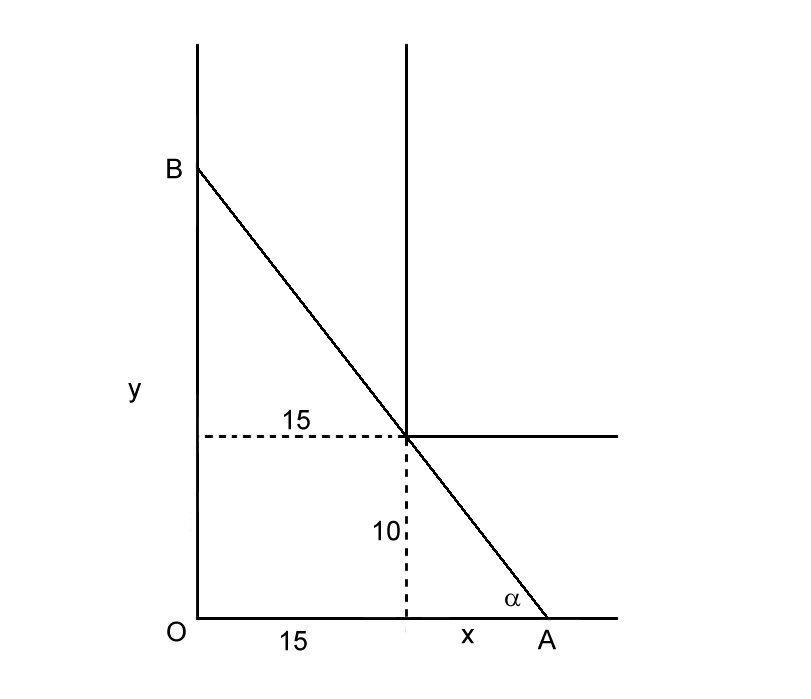A steel girder is taken to a 15ft wide corridor. At the end of the corridor there is a 90° turn, to a 9ft wide corridor. How long is the longest girder than can be turned in this corner?
1 Answer
Maximum girder length is
Explanation:
Let us set up the following variables:
# {(x, "Partial distance along bottom",x+15=OA), (y, "total length along side",y=OB), (l, "Line Segment AB",l=AB),(alpha, angle " between AB and bottom",) :} #
All of

As the girder is moved through the corner of the corridor, it will get stuck if it is ever longer than the line segment
METHOD 1
Our aim is to find
By Pythagoras:
# AB^2=OA^2+OB^2 #
# :. l^2=(15+x)^2+y^2 #
By similar triangles:
# OB : OA = 10 : x #
# :. y/(15+x) = 10/x #
# :. y = (10(15+x))/x #
Combining these results we get:
# :. l^2=(15+x)^2+((10(15+x))/x)^2 #
By taking the (positive) square root we have achieved our goal of getting
# L = (15+x)^2 + (100(15+x)^2)/x^2 #
# \ \ = (15+x)^2(1+100/x^2) #
Differentiating wrt
# (dL)/dx = (15+x)^2(-200/x^3)+2(15+x)(1+100/x^2) #
# " " = (15+x){-200/x^3 (15+x) + 2(1+100/x^2) }#
# " " = (15+x)( -3000/x^3 - 200/x^2 + 2+200/x^2 )#
# " " = (15+x)(2 -3000/x^3 )#
At a max/min we have
Either
# 15+x = 0 = > x=-15 # . But#x gt 0#
Or# \ \ \ \ \ \ 2 -3000/x^3 = 0 => 1500/x^3=1 => x=1500^(1/3)#
Thus we have:
# x = 11.44714 ... #
# L = 1233.2326... #
# l \ = 35.11741 ... #
I won't show that this is minimum (as required) but a plot or the second derivative test will show this is the case.
METHOD 2
We can also use a max/min method using trigonometry, considering the angle
From the large
# cos alpha = (15+x)/l #
# :. l = (15+x)/cos alpha #
# :. l = (15+x)sec alpha #
From the small
# tan alpha = 10/x #
# :. x = 10/tan alpha #
# :. x = 10cot alpha #
Combining these results we get:
# l = (15 + 10 cot alpha)sec alpha #
# \ = 15sec alpha + 10 cot alpha sec alpha #
# \ = 15sec alpha + 10 cos alpha /sin alpha 1/cos alpha #
# \ = 15sec alpha + 10 /sin alpha #
# \ = 15sec alpha + 10 csc alpha #
Differentiating
# (dl)/(d alpha) = 15sec alpha tan alpha - 10 csc alpha cot alpha #
At a max/min we have (dl)/(d alpha) #
# :. 15sec alpha tan alpha - 10 csc alpha cot alpha = 0 #
# :. 3/(cos alpha) (sin alpha)/(cos alpha) = 2/(sin alpha) (cos alpha)/(sin alpha) #
# :. 3sin^3alpha=2cos^3alpha #
# :. tan^3alpha=2/3 #
From which we get:
# alpha = 0.71802 ... ^c#
# alpha = 41.1398 ... ^o#
# l \ = 35.1174 ... # , as with Method 1

